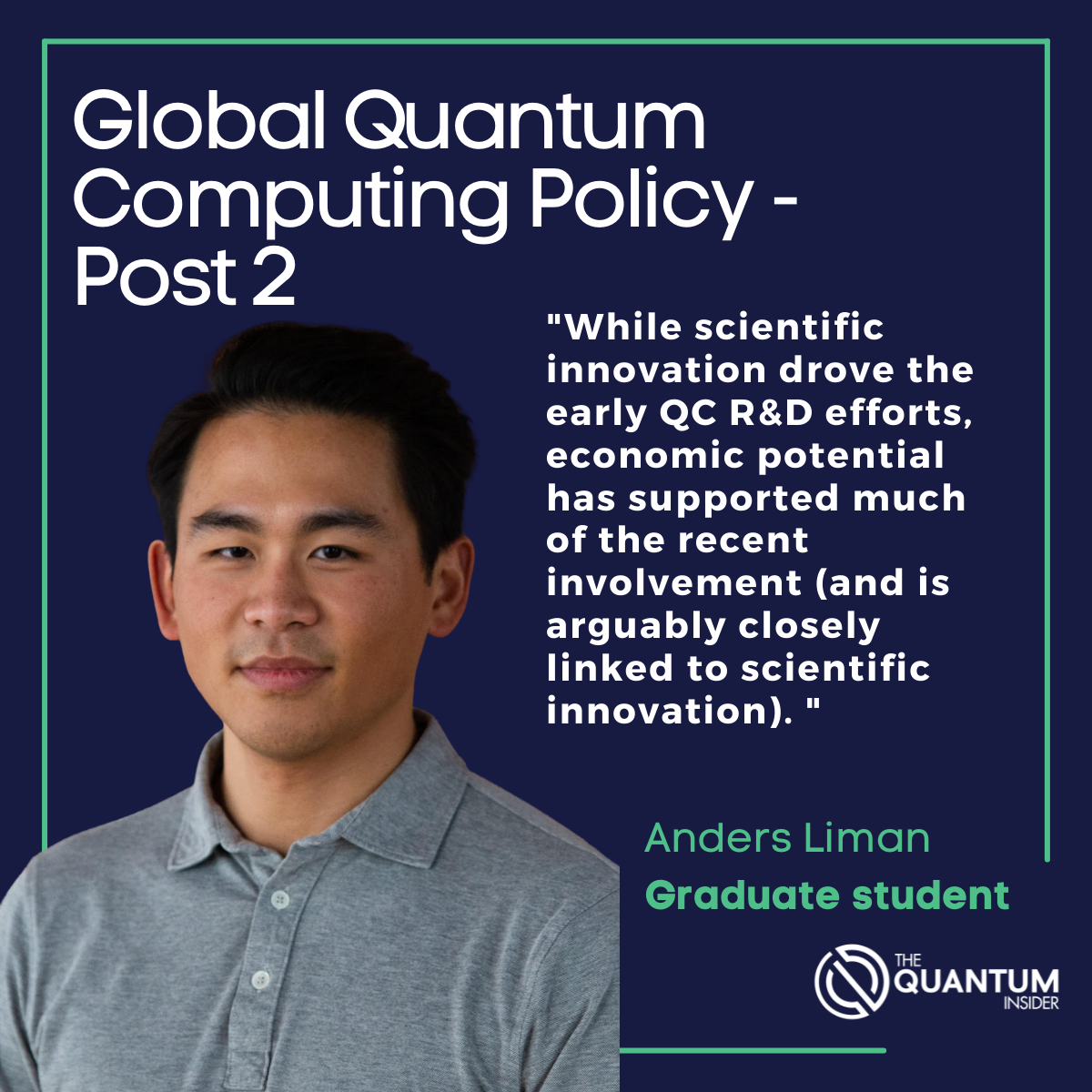My name is Anders Liman. I’m a graduate student studying Tech Ethics and Science Policy at Duke University. I also hold a master’s in Computer Science from North Carolina State University. This summer, as part of a collaboration between Duke and Google, I researched the global quantum computing landscape in an effort to identify engagement challenges and opportunities in the field. This blog series is the fruit of this labor. You can find all the posts in the series written here:
Post 1 – Researching the global quantum computing landscape in an effort to identify engagement challenges and opportunities in the field
Post 2 – How scientific innovation and economic potential drive academic and industry efforts in quantum computing
Post 3 – How national security and digital sovereignty motivate governmental efforts in quantum computing
Post 4 – Competing interests, competing ideals, and unwanted hype in quantum computing, and ways to address them
Post 5 – Identifying NISQ applications, addressing workforce gaps, and developing future workforce in quantum computing
Post 6 – Properly framing quantum computing and setting appropriate expectations
Surveying various stakeholders involved in QC R&D around the world, four common motivations for QC investment emerge: scientific innovation, economic potential, national security, and technological sovereignty. We’ll focus on scientific innovation and economic potential in this post. Depending on the nation and sector, different stakeholders may articulate different motivations and to different degrees. Moreover, many stakeholders have more than one motivation.
Note: Each section includes representative stakeholders typifying the motivation, largely based on the stakeholders’ public disclosure, with which the actual/internal motivation(s) may or may not align. The lists are neither exclusive nor exhaustive.

Scientific Innovation
The first widely shared motivation may be the purest: scientific innovation. The desire to advance science and bring innovation pushes many stakeholders to undertake QC R&D.
This motivation is most often seen in academia, including universities and national research labs/institutes. This is also commonly the motivation of some science-focused departments and offices in governments. Often these departments and offices support the R&D work in aforementioned universities and research labs/institutes. Finally, this motivation is also seen in research divisions in large corporations.
US: Caltech, Duke, Google Research, IBM Research, NSF, NSTC, ORNL, Sandia;
CA: IQ, ISED, PI, UBC, Waterloo;
UK: Cambridge, EPSRC, Oxford, STFC;
DE: acatech, BMBF, Fraunhofer, Max Planck;
FR: CNRS, INRIA, Sorbonne;
CN: CAS, USTC;
JP: JST, MEXT, Osaka, RIKEN, Tokyo;
AU: ANU, UNSW, UTS.
Economic Potential
While scientific innovation drove the early QC R&D efforts, economic potential has supported much of the recent involvement (and is arguably closely linked to scientific innovation). Virtually every stakeholder that is not listed above (and many listed above) is drawn to QC by its economic potential.
While this motivation is prevalent among most stakeholders, it is most pronounced among industry players, large and small.
Large consulting companies like McKinsey (projecting USD 700b value by 2035) and the Boston Consulting Group (projecting USD 850b value by 2040) have contributed to the prevalence of this motivation. Economic potential is also largely responsible for QC startups securing funding and ensuring livelihood. Some have accused startups of claiming overblown economic potential only to secure funding. It is also unclear to what extent these overblown claims fuel the aforementioned market predictions, thus feeding into an economic hype cycle.
US: Amazon, ColdQuanta, Google, IBM, IonQ, Microsoft, Quantinuum;
CA: 1QBit, D-Wave, Xanadu;
UK: OQC, ORCA, Riverlane;
DE: Avanetix, HQS, KEEQuant, Q.ANT, QOJ;
FR: Pasqal;
CN: Alibaba, Baidu, Tencent;
JP: Hitachi, NEC, Toshiba;
AU: Quantum Brilliance, SQC.
Next Up
Post 3 – How national security and digital sovereignty motivate governmental efforts in quantum computing
Looking Ahead
Post 4 – Competing interests, competing ideals, and unwanted hype in quantum computing, and ways to address them
Post 5 – Identifying NISQ applications, addressing workforce gaps, and developing future workforce in quantum computing
Post 6 – Properly framing quantum computing and setting appropriate expectations
Previously
Post 1 – Researching the global quantum computing landscape in an effort to identify engagement challenges and opportunities in the field
Acknowledgements
The author would like to express sincere gratitude to the following organizations and individuals for their valuable insights which prove integral to the creation of this blog series: Google Quantum AI team, Google Government Affairs and Public Policy team, Thomas Monz (AQT), Christina C. C. Willis (ColdQuanta), Lamont Silves (IonQ), Ken Brown (Duke University), Jonathan Felbinger (QED-C / SRI International), Carl Williams (CJW Quantum Consulting), Matt Trevithick (DCVC), and David Moehring (Cambium Capital).
The author would also like to express sincere gratitude to the following individuals for their support and counsel throughout the research: Kate Weber (Google), Ashley Zlatinov (Google), Charina Chou (Google), Lee Tiedrich (Duke University), and Buz Waitzkin (Duke University).
For more market insights, check out our latest quantum computing news here.
















